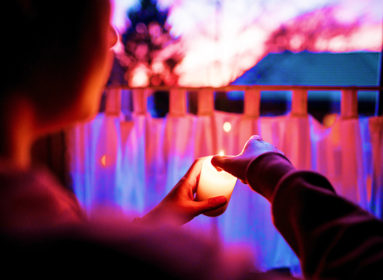
(Left to right): Rabbi Shelley Kovar Becker, Kevin Andersen, Mike Liftman, Barbi Liftman (holding the Torah), Sue Kleinman, Alice Holloway, Ron Kleinman, Marty Becker at the West Essex, N.J. synagogue in May
By Cindy Mindell ~
SOUTHINGTON – It’s been several years since Gishrei Shalom Jewish Congregation (GSJC) has considered adopting a World War II-era Torah scroll. Finally, last month, their plans materialized.
“All of a sudden last summer people became excited about the idea and pledged money,” says Barbi Liftman, president of the Southington congregation. “It went from an idea to a reality very quickly. We feel that it is important to teach our children about the Holocaust and to remember that we are still alive and vibrant.”
Rabbi Shelley Kovar Becker suggested that the congregation apply to become “shomrim,” or guardians, of a scroll, through the Czech Memorial Scrolls Trust, the repository of Torah scrolls recovered after World War II from a destroyed Jewish community, and housed at the Westminster Synagogue in London.
Donors stepped forward; the application was accepted. In early May, Becker led a delegation of six GSJC congregants to Temple Sholom in West Essex, N.J., the east coast repository for the Trust. The group was invited to choose from three available Torah scrolls.
“One was very damaged, and of the other two, we chose the most beautiful one,” says Lifton. “One was so much more beautiful and the script was so much more unusual.” The unknown scribe took special care with the letters “pey” and “fey,” embellishing them with a distinctive curlicue, Becker says.
Written in 1780, the scroll is one of the oldest in the repository’s collection. The Jewish Museum in Prague tracked its origins to a region of central Behomia, some 45 miles southeast of Prague. In the town of Caslav, a Jewish congregation of around 300 members was founded in 1870, dwindling to 119 by 1930.
While extensive damage to the scroll renders it non-kosher for regular usage, the Torah will not be relegated to a display case, Becker says.
“It was always my intention, in acquiring a rescued scroll, for it to reside in our ark,” she says. “We would not lock it away, because to me, that is telling the Nazis that we’re doing exactly what they wanted us to do. Even if it’s a non-kosher scroll, that’s not the way to handle it, and my congregation agreed.”
In addition to educational purposes, the scroll will be used in bar/bat mitzvah ceremonies in two ways, Becker says. Where legible, and with the family’s permission, a bar or bat mitzvah will be allowed to read his or her portion from the scroll during the service. The scroll will also be used in the congregation’s traditional “passing down” from the oldest generation of the bar mitzvah family to the youngest.
“The bar or bat mitzvah is the generation who should not be here, according to Hitler,” Becker says. “How much more meaningful this scroll becomes when we put it into the arms of these children who should not be alive.”
On Shabbat, May 19, the “adopted” scroll was introduced to the congregation in just this way, at the b’nai mitzvah of Hannah and Jack Hale, who traded off carrying the rescued Torah around the sanctuary.
The scroll was officially welcomed on Shavuot. A formal dedication ceremony is planned for the fall. Becker hopes to plan a congregational “pilgrimage” to the Czech Republic and the trust at Westminster Synagogue.
The adoption is not only significant to the congregation and fellow Jews, Becker says. “It’s also important for the non-Jewish community to know that these scrolls still exist, that they can live again,” she says. “Not everything was destroyed. We have the great good fortune to have the scroll and share it with anyone who would like to see it. We are delighted to show it off.”







 Southern New England Jewish Ledger
Southern New England Jewish Ledger













